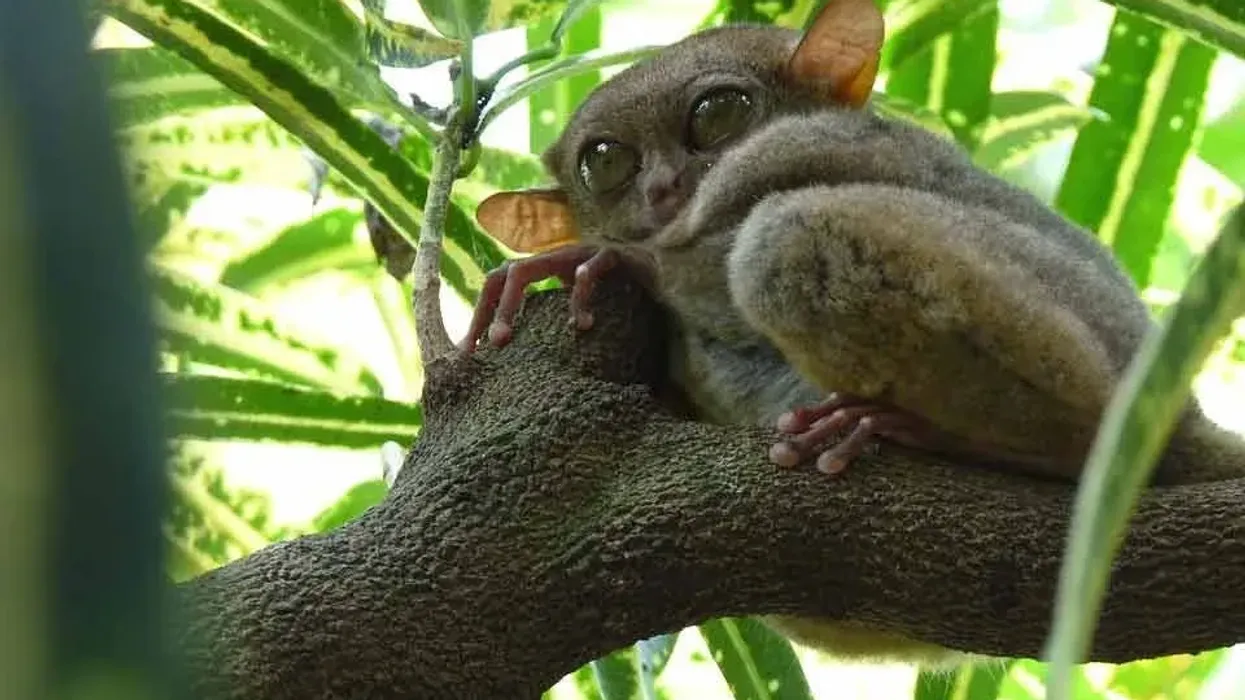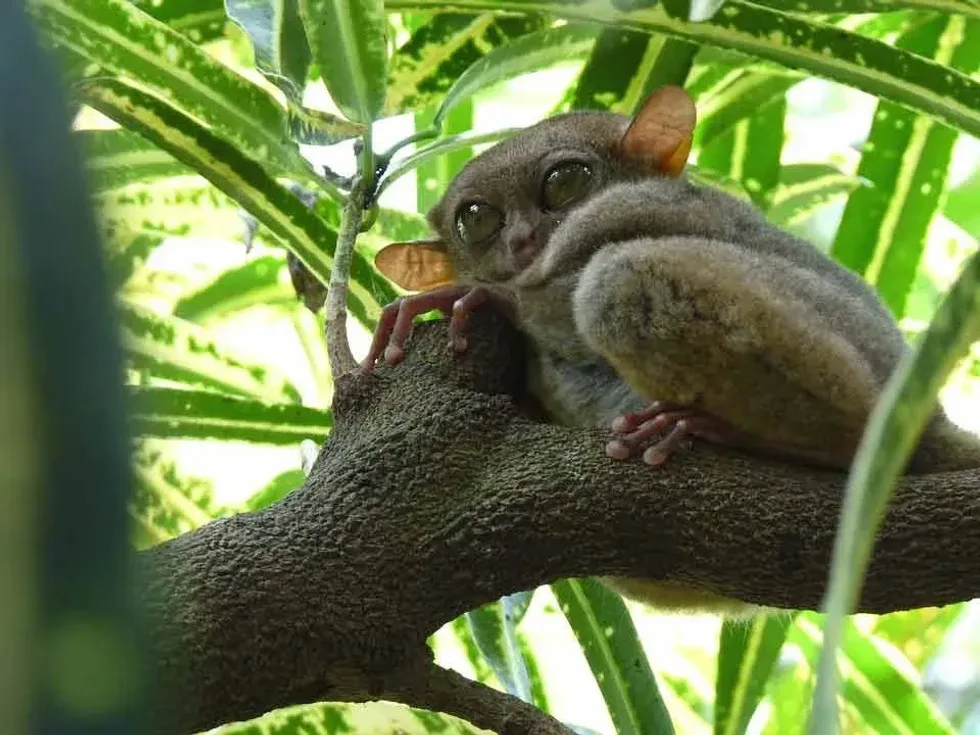A Philippine tarsier is a tarsier species native to the Philippines and it is one of the worlds smallest primates. Tarsier is pronounced as taar-see-ur. It is nearly threatened and is endemic to the Southwestern portion of the Philippine archipelago.
Tarsiers get their name from their surprisingly elongated tarsier bone. Tarsiers are typically called Mawuman, Mamag.
Tarsiers are comparatively lazy mammals, who tend to loathe around and sleep during the day and hunt during the night. Tarsier species are categorized as Eastern tarsiers and Western tarsiers. Tarsiers have very large eyes that are always fixed at one place and are proportionately very large as compared to their body size.
Their heads often rotate like owls. Tarsier ears are flexible and hairless which tend to detect even the smallest bit of movement.
Their small size makes it difficult to spot them. Tarsiers have a tail that is double the size of their body. Tarsiers are entirely insectivorous creatures and feed on other small insects.
Eastern tarsiers differ from western tarsiers in various behavioral aspects. Young tarsiers are born with their eyes open and fur on their body, Tarsiers are able to climb up trees within a day of the birth.
Tarsiers are recognized as some of the oldest primates with fossils dating back million years found in North America, Asia, and Europe. Due to uncontrolled and illegal pet trade, their population is dwindling and conservation efforts are required to save them from extinction.
Here are some true facts about the Tarsier monkey along with various fun facts that you will surely enjoy. After reading Philippine tarsier facts, you may also look at pygmy slow loris facts and eastern lowland gorilla facts.
Tarsier Interesting Facts
What type of animal is a tarsier?
A Philippine tarsier is the world's smallest primate and is entirely carnivorous, feeding mostly on insects. The most captivating feature of tarsiers are their eyes. Tarsiers are extremely large and fixed in one place. This makes the tiny primate look surprised.
Since their eyes cannot move, their heads are extremely flexible like owls. They are also nocturnal animals, who sleep during the day and hunt at night. Tarsiers have large hairless ears that can detect even a slightest insect movement.
What class of animal does a tarsier belong to?
Tarsiers fall under the class of mammals because of their ability to give birth. They are the world's smallest primates and give birth to only one baby after a gestation period of six months.
How many tarsiers are there in the world?
It has been estimated that there are only 5,000-10,000 Philippine tarsiers left in the world. Tarsiers are slowly decreasing in number and are near threatened, becoming extinct. They don't live long in captivity.
Where does a tarsier live?
The Philippine tarsier is a native to the Philippine archipelago. Tarsiers are typically found in the Southeast portion of the archipelago: specifically, the islands of Mindano, Leyte, Siarago, Dinagat, Maripipi, Samar, Basilan and Bohol. Tarsiers stay limited to these islands and are not found anywhere else.
What is a tarsier's habitat?
Tarsiers prefer to live in the secondary forests because they are able to regenerate after a major event like deforestation or a fire. Tarsiers can leap over 5 m, which is around 40 times of their body length. They love to spend their time on tree branches.
Who do tarsiers live with?
Tarsiers are wild mammals and cannot live long in captivity. Tarsiers live in secondary forests and are usually found in pairs who communicate in the night during the hunt. Most of their lives are spent clinging to tree branches.
How long does a tarsier live?
If the Philippine tarsier is healthy and not captive, and able to stay in his habitat without intervention, then it can live up to 24 years. However, their lifespan decreases drastically when tarsiers are held captive due to tarsier suicidal instincts.
Instances suggest that the Philippine tarsier is known to commit suicide when they are confined to a room. Tarsiers tend to bang their heads to the wall until they break their skull. This is why they should never be caught.
How do they reproduce?
The Philippine tarsier givsn birth to only one baby after a gestation period of six months. The male deposits a sperm plug after mating in the female's vagina. This gives the sperm a better chance to reach the egg.
The offspring is usually born with open eyes and little fur. They are 25% the weight of their mothers. After they are born, they are guided by their mothers for a period of six months after which they become self sufficient.
What is their conservation status?
Philippine tarsiers have been increasingly kept captive which is drastically reducing their lifespan. There are only 5000-10000 tarsiers left in the entire world, reaching the nearly threatened class of the conservation status due to illegal pet trade and habitat loss.
Tarsier Fun Facts
What do tarsiers look like?
A Philippine tarsier is the smallest primate in the world. The eyes of the tarsier are very unique, these enormous eyes make them look as surprised all the time.
Since tarsiers cannot move their enormous eyes, they have very flexible heads which can rotate up to 180 degrees in each direction just like owls. Their eye to body size ratio is the largest for any mammal.
They have hairless, large and soft ears which can distinguish even the smallest insect movement. Tarsiers have tails that are twice as long as them which helps them to balance in tree canopies. They have short and soft fur of various colors ranging from brown, grey to red.
Tarsiers have long fingers and toes which help them climb the trees easily. Tarsiers have long and thin fingers.
The second and third finger feature curved and long claws that are used for grooming. The head and body of the tarsiers is between four to six inches long while they twice as long hind legs.

How cute are they?
The small size and the long tail of the Philippine tarsier makes it look very cute. They are so tiny that it is often very difficult to spot them. Their eyes give the mammal a surprised look which is very attractive and unique.
How do they communicate?
They are known to use an elaborative technique to communicate. They use around seven different sounds to communicate, namely a loud call, a smack whistle, a whistle, a chirp, a trill, a cheep and a twitter.
They almost use smell to communicate. Males are known to mark their territory with urine and females often secrete a scent from their gland near their mouths to mark their mates.
How big is a tarsier?
A Philippine tarsier is the smallest primate. Because of their size they are very difficult to spot. Males only weigh up to 0.35 lb and the females are much lighter. They are only four to six inches tall.
How fast can a tarsier move?
The tarsier's small body, long tail and toes help them move and climb very swiftly. They move at an average speed of 24 mph.
How much does a tarsier weigh?
They are very light weight and weigh around 0.35 lb. The females are even lighter.
What are their male and female names of the species?
They have no distinct names based on sex. They are just called male Philippine tarsier and female Philippine tarsier.
What would you call a baby tarsier?
There is no specific name for a baby tarsier, they are referred to as newborn or infant tarsier.
What do they eat?
They are insectivorous and primarily eat insects, spiders, small crustaceans, small vertebrates like lizards. They are nocturnal animals and sleep and loathe around during the day time and prey on live insects and grasshoppers in the night time.
Are they loud?
Tarsiers usually live in pairs and communicate with their fellow beings in the night time. This is when they are a little loud. They call out loud calls and communicate through whistles to alert their fellow mates.
Would they make a good pet?
The Philippine tarsier have a specific habitat that they are most comfortable in. This environment can not be provided artificially. Hence it is not recommended to captivate them. It is also known that their lifespan decreases enormously when held captive. They also become suicidal and bang their heads to the walls when they are kept in a room.
Did you know...
A Philippine tarsier is called as mamag, magau , mago by natives.
They can leap a distance of 16.4 ft.
They have an ability to rotate their head to a complete 180 degrees.
They can hear frequencies up to 91 kHz.
Unique features of the tarsier
They have very large eyes that are stuck to their skull. Along with this, they have very flexible heads which allow them to turn up to 180 degrees in any direction.
Their very long tails are double their size. Plus, they have large, hairless and flexible ears that capture even the smallest insect movements. They have small and soft fur that are brown, grey or red in color.
Characteristics of the tarsier
Tarsiers are the smallest primates in the world and tarsiers can live up to 24 years of age. With only 5000-10000 tarsiers left alive, this species is nearly threatened to extinction and needs protecting.
Here at Kidadl, we have carefully created lots of interesting family-friendly animal facts for everyone to discover! Learn more about some other mammals including mangabey, or old world monkeys.
You can even occupy yourself at home by drawing one on our Tarsier coloring pages.








